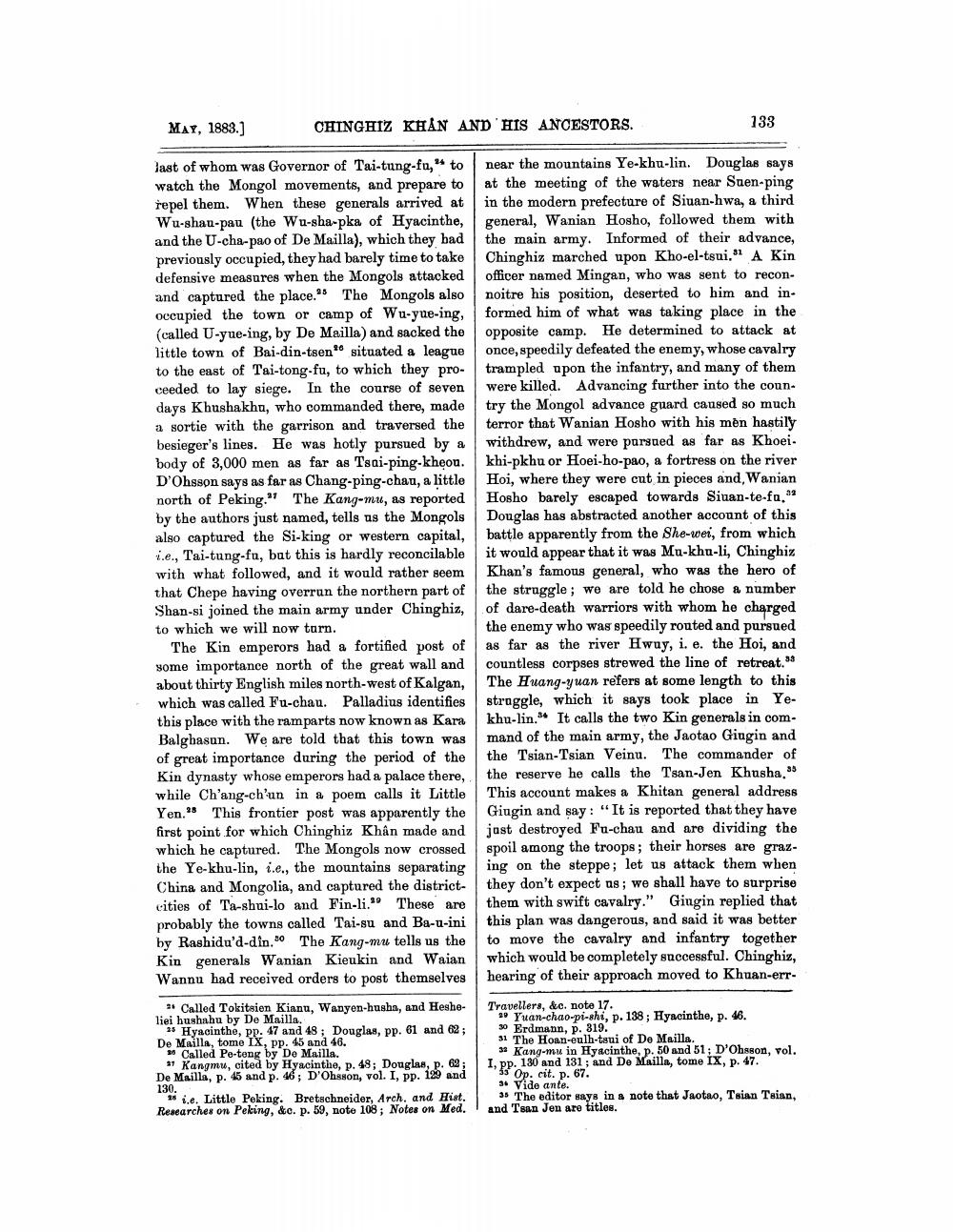________________
MAY, 1883.)
CHINGHIZ KHAN AND HIS ANCESTORS.
133
Jast of whom was Governor of Tai-tung-fu," to Watch the Mongol movements, and prepare to řepel them. When these generals arrived at Wu-shau-pau (the Wu-sha-pka of Hyacinthe, and the U-cha-pao of De Mailla), which they had previously occupied, they had barely time to take defensive measures when the Mongols attacked and captured the place. The Mongols also occupied the town or camp of Wu-yue-ing, (called U-yue-ing, by De Mailla) and sacked the little town of Bai-din-tsenos situated a league to the east of Tai-tong-fu, to which they proceeded to lay siege. In the course of seven days Khushakha, who commanded there, made a sortie with the garrison and traversed the besieger's lines. He was hotly pursued by a body of 3,000 men as far as Tsai-ping-kheon. D'Ohsson says as far as Chang-ping-chau, a little north of Peking." The Kang-mu, as reported by the authors just named, tells us the Mongols also captured the Si-king or western capital, i.e., Tai-tung-fu, but this is hardly reconcilable with what followed, and it would rather seem that Chepe having overrun the northern part of Shan-si joined the main army under Chinghiz, to which we will now turn.
The Kin emperors had a fortified post of some importance north of the great wall and about thirty English miles north-west of Kalgan, which was called Fu-chau. Palladius identifies this place with the ramparts now known as Kara Balghasun. We are told that this town was of great importance during the period of the Kin dynasty whose emperors had a palace there, while Ch'ang-ch'un in a poem calls it Little Yen." This frontier post was apparently the first point for which Chinghiz Khân made and which he captured. The Mongols now crossed the Ye-khu-lin, i.e., the mountains separating China and Mongolia, and captured the district- cities of Ta-shui-lo and Fin-li." These are probably the towns called Tai-su and Ba-u-ini by Rashidu'd-dîn. The Kang-mu tells us the Kin generals Wanian Kieukin and Waian Wannu had received orders to post themselves
near the mountains Ye-khu-lin. Douglas says at the meeting of the waters near Suen-ping in the modern prefecture of Siuan-hwa, a third general, Wanian Hosho, followed them with the main army. Informed of their advance, Chinghiz marched upon Kho-el-tsui." A Kin officer named Mingan, who was sent to recon. noitre his position, deserted to him and in formed him of what was taking place in the opposite camp. He determined to attack at once, speedily defeated the enemy, whose cavalry trampled upon the infantry, and many of them were killed. Advancing further into the country the Mongol advance guard caused so much terror that Wanian Hosho with his mėn hastily withdrew, and were parsued as far as Khoei. khi-pkhu or Hoei-ho-pao, a fortress on the river Hoi, where they were cut in pieces and, Wanian Hosho barely escaped towards Siuan-te-fa, Douglas has abstracted another account of this battle apparently from the She-wei, from which it would appear that it was Mu-khu-li, Chinghiz Khan's famous general, who was the hero of the struggle; we are told he chose a number of dare-death warriors with whom he charged the enemy who was speedily routed and pursued as far as the river Hway, i. e. the Hoi, and countless corpses strewed the line of retreat." The Huang-yuan refers at some length to this straggle, which it says took place in Yekhu-lin. It calls the two Kin generals in command of the main army, the Jaotao Giugin and the Tsian-Tsian Veinu. The commander of the reserve he calls the Tsan-Jen Khusha." This account makes a Khitan general address Giugin and say: "It is reported that they have just destroyed Fu-chau and are dividing the spoil among the troops; their horses are grazing on the steppe; let us attack them when they don't expect us; we shall have to surprise them with swift cavalry." Gingin replied that this plan was dangerous, and said it was better to move the cavalry and infantry together which would be completely successful. Chinghiz, hearing of their approach moved to Khuan-err
** Called Tokitsien Kianu, Wanyen-husha, and Hesheliei hushahu by De Mailla.
* Hyacinthe, pp. 47 and 48 ; Douglas, pp. 61 and 62; De Mailla, tome IX, pp. 45 and 46.
* Called Pe-teng by De Mailla. * Kangmu, cited by Hyacinthe, p. 49; Douglas, p. 62 De Mailla, p. 45 and p. 46; D'Ohsson, vol. I, pp. 129 and
* i.e. Little Peking. Bretschneider, Arch. and Hist. Researches on Peking, &c. p. 59, note 108; Notes on Med.
Travellers, &c. note 17. * Yuan-chao-pi-shi, p. 138 ; Hyacinthe, p. 46. 30 Erdmann, p. 319. 31 The Hoan-eulh-teni of De Mailla.
» Kang-mu in Hyacinthe, p. 50 and 51; D'Ohsson, vol. I, pp. 130 and 131 ; and De Mailla, tome IX, p. 47.
3 Op. cit. p. 67. 3. Vide ante.
The editor says in a note that Jaotao, Tsian Teian, and Tsan Jon are titles.
130.
|




